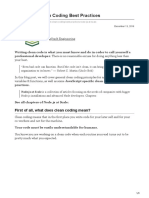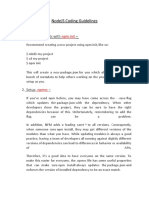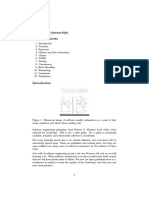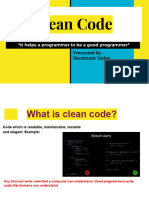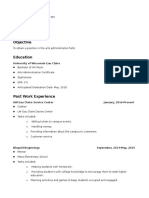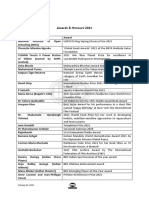1.
Naming Conventions
General Naming Guidelines: Avoid overly general or vague names, like data_structure
or info_map. Instead, use meaningful names, like userProfile or menuOptions, which
make the code self-explanatory.
Variables and Functions (camelCase): Use camelCase for variable and function names
to make identifiers consistent and readable (e.g., calculateTotalPrice or
isUserActive).
Constants (UPPERCASE_WITH_UNDERSCORES): Constants are defined in all uppercase
letters with underscores to indicate that they are immutable values, like MAX_USERS
or API_URL.
Classes (PascalCase): Class names follow PascalCase to distinguish them from other
identifiers, like UserProfile or BankAccount.
Booleans (Prefix with is): Boolean variables and methods are prefixed with is or
has, improving readability and clarity (e.g., isSubmitted, hasAccess).
2. Code Layout
Indentation (4 spaces): Use 4 spaces for each indentation level for a clean,
consistent structure that improves readability.
Maximum Line Length (80 characters): Limit lines to 80 characters to avoid
horizontal scrolling and make code easier to read.
Blank Lines: Insert blank lines between logical sections of code to enhance
readability and visual separation.
Whitespace in Expressions: Avoid excessive whitespace in expressions and
statements. For example, write const result = (x + y) * z rather than adding spaces
around every parenthesis.
Semicolons: Always use semicolons to avoid potential issues with JavaScript’s
automatic semicolon insertion (ASI).
3. Comments and Documentation
Comments: Use single-line comments (//) for brief explanations and multi-line
comments (/* */) for longer descriptions. Comment complex logic to make it
understandable for future readers.
JSDoc Documentation: For public functions and classes, use JSDoc-style comments,
which include parameter and return type descriptions (e.g., @param {number} a).
JSDoc improves documentation and integrates well with IDEs.
4. Declarations and Assignments
Variable Declarations (const and let): Use const for immutable values and let for
variables that may change. Avoid var as it has function-scoped behavior and may
cause bugs.
Destructuring: Use destructuring to simplify code when working with objects and
arrays. For example, const { name, age } = user; makes accessing properties easier.
Spread Operator: Use the spread operator (...) to copy or merge arrays and objects.
This is a cleaner alternative to methods like Object.assign() and helps avoid
mutation issues.
5. Object and Array Manipulation
Destructuring for Readability: Destructuring can make code more readable by
allowing direct assignment of object properties and array elements to variables.
It’s especially useful in function parameters and array operations.
Spread Operator for Copying and Merging: Use the spread operator for immutably
copying and merging objects and arrays, promoting functional programming principles
in JavaScript.
6. Member Access and Modifiers
Public Members: Use standard naming conventions for public properties and methods,
with camelCase for instance methods (e.g., getUserDetails).
Protected Members (Prefix with _): By convention, prefix protected members with an
underscore (_) to indicate they are intended for internal use, although JavaScript
doesn’t enforce access levels.
Private Members (Prefix with #): Use # for private members in classes (e.g.,
#password). This makes them accessible only within the class, a feature available
in modern JavaScript.
7. Error Handling
�try/catch Blocks: Use try/catch blocks for handling synchronous errors and to
prevent application crashes.
Promises and async/await: Use Promises with .then() and .catch() or async/await for
asynchronous operations. This helps manage asynchronous code clearly and allows for
centralized error handling.
8. Class Member Order
Standardized Member Order: Arrange members in a specific order within a class:
Static properties
Static methods
Instance properties
Constructor
Public methods
Private/protected methods
Consistent Structure: This order makes class definitions uniform and easier to
understand.
9. Asynchronous Patterns
Handling Multiple Promises (Promise.all): When handling multiple asynchronous
operations, Promise.all runs them in parallel and waits for all to resolve or any
to reject.
Promise.race: Use Promise.race when only the first resolved promise result is
needed, which is efficient for tasks where only the quickest result is required.
10. Best Practices for Performance
Optimize Loops: Avoid redundant calculations inside loops. For example, assign
values to variables outside the loop when possible.
Minimize DOM Manipulations: Batch updates to the DOM to reduce reflows and
repaints, improving performance.
Event Delegation: Use event delegation to efficiently manage events for dynamically
created elements.
Throttling and Debouncing: Use throttling and debouncing for high-frequency events
(e.g., scroll, resize) to improve performance. This can be done with utility
libraries like Lodash.
11. Security Best Practices
Avoid eval(): eval() executes a string as code, making applications vulnerable to
code injection. Avoid it and use safer alternatives.
Escape User Input: Sanitize and escape user input to prevent Cross-Site Scripting
(XSS) and other injection attacks, especially when displaying data in the DOM.
12. Modern ES6+ Features
Template Literals: Use template literals ( ) for easier string construction and
improved readability.
Default Parameters: Set default values for function parameters to handle cases
where arguments are missing.
Rest and Spread Operators: Use the rest (...args) and spread (...array) operators
for cleaner array and object manipulations, such as merging or cloning.
13. References
The document references established JavaScript style guides like Airbnb and Google
for additional best practices. Other resources include MDN Web Docs, ECMAScript
documentation, Node.js best practices, and the Prettier formatting tool.

